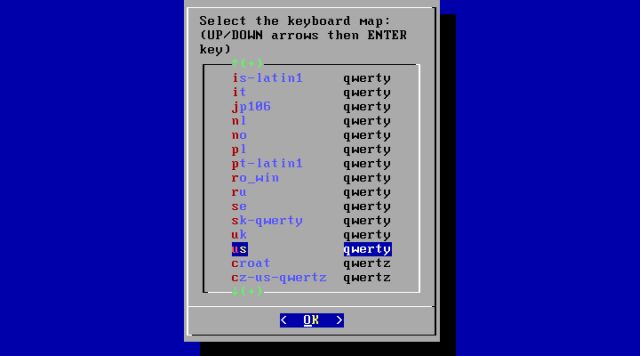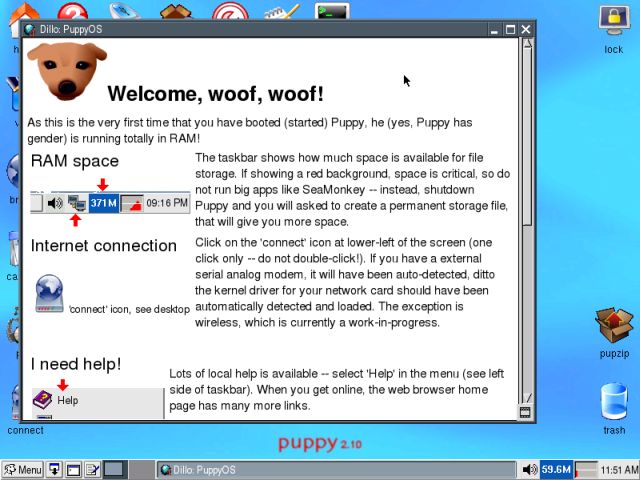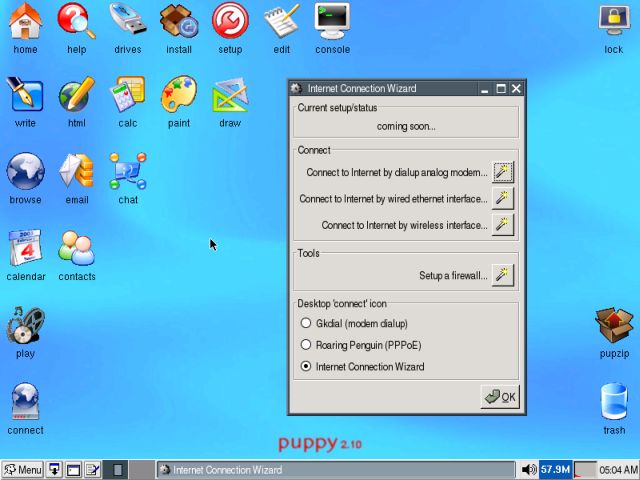Updated: May 23, 2007; November 30, 2008
Note: I have written a new review on version 4.1 - the below text covers version 2.1. The new article covers in details the fresh, beautiful changes in Puppy since, including Wireless support, multimedia codecs (MP3, Flash) out of the box, Samba sharing, NTFS support, anti-virus scanning for Windows machines, remastering of USB disks, a broad range of programs, and more. Please take a look.
Puppy Linux is a lightweight, fast, highly customizable, and highly versatile Linux distribution. It is well suited for people running low-end machines, users interested in privacy or newcomers to the Linux world who wish to undergo their first experience by running a Linux live CD. Additionally, Puppy can handsomely supplement Windows users as a handy diagnostics, backup, rescue, and/or recovery tool. There are many reasons why just about anyone should use Puppy:
Puppy Linux is tiny (40-80MB). Puppy Linux will gladly run on old PCs, with as little as 128MB RAM. Puppy Linux can be installed to just about any device - CD, USB drive, ZIP drive, or hard disk. Puppy Linux loads completely into the RAM (allowing you to reuse your CD drive for burning, for example). Puppy Linux allows you to save your sessions (including Internet history and data) to external storage, including CDs. Puppy Linux offers a good support to a wide range of hardware and will load the best suited kernel to match your computer's anatomy; furthermore, setup and configuration of hardware devices and system utilities is greatly simplified by the use of very friendly wizards. Puppy Linux can be used to analyze unbootable hard disks and help you salvage crucial data. And so much more.
That's it?
Hardly. We're justing warming up. You'll be amazed how much goodness can be packed into 60MB. As if the above facts are not enough, Puppy offers a broad range of applications for instant full-spectrum productivity. The standard tools include web browsers, the super-small Dillo browser (only 350K) and the SeaMonkey suite, complete with Composer HTML editor, GAIM messenger, AbiWord processor, gxine media player, and some more.
Things become more specialized with the TightVnc VNC client, LinNeighborhood Samba client, BetaFTPD FTP server, Rdesktop remote desktop client, Gnumeric Excel-compatible spreadsheet, puppyPDF PDF converter, a range of scientific calculators, a host of other applications. You can also expect support for wireless devices, too.
All in all, there are more than 450 packages available, including a number of desktop managers. Windows fans will be able to install the IceWM desktop, which offers a more Windowsy feel. A mighty punch, I dare say.OK, that's it?
Nope. Puppy comes in many flavors. Bare-bones Puppy has no GUI and weighs only 40MB. The heavyweight Chubby Puppy, which packs the full Open Office suite, is an enormous 100MB in size. Real connoisseurs (read geeks) will probably want to make their own customized versions of Puppy. This is what Puppy Unleashed was made for. Depending on your install, Puppy Linux will become hard Puppy, thin Puppy, zippy Puppy, flash Puppy, and many other naughty Puppies.Links
My introduction may create a false impression of a confusion, with so much information, especially concerning different versions and packages. But things are rather simple.
You can find the adorable Puppy on the official Puppy Linux site or the community Puppy Linux Home site. At this stage, you should probably only be interested in the nominal live CD, which is - do not get confused - also a multi-session CD/DVD! And depending on where you install it (if at all), it might get another spicy title like thin, hard or zippy. At the time of conception of this mine article, the latest Puppy release is Puppy Linux 2.12.
You can download the standard puppy-2.12-seamonkey.iso or enhanced puppy-2.12-seamonkey-zdrv.iso, with extra drivers, from ibiblio.org or Puppy Linux Home download section.
If you wish to try one of the older (for instance, Puppy 2.00 with Opera browser) or alternative Puppy releases, which features different packages, you might try the other at Puppy Linux Home (above) or MyMirrors.HomeLinux.org.
Creating your own version of Puppy from the assorted 450 + packages can be done using Puppy Unleashed. More information is available in Package Management and Puppy Unleashed sub-sections on the official site. The version can also be downloaded from ibiblio.org. You might also be interested in Puppy Linux Video Tutorials.
A Puppy Tour
Let's begin. Puppy is as simple as it gets. Place the CD into the tray (after you burned the .iso file) and reboot. Puppy Linux will present you with a boot screen that you can ignore at this stage, since you have just started using the live CD.

After a few moments, you will be asked to choose your keyboard layout.

After that, comes the choice of the graphic driver. The choices presented in the Video Wizard (sounds like a wicked trick from the 80s), are rather self-explanatory. Since you are booting off from a CD, there is no harm in trying the more advanced Xorg driver. You will always be able to revert to the basic Xvesa.

Puppy should boot now into its default desktop (Xfce) and present you with the second Video Wizard challenge. Again, the instructions are simple.

Welcome to Puppy Linux! The entire procedure should not have taken more than a minute. Regardless, Puppy 2.10 was quickly "patched" to 2.11, because the boot times were found to be slow on older machines, due to a different compression. On new computers, you should hardly feel the difference. The first time you boot to a session, you will be presented with a brief introduction to Puppy, including a few basic guidelines.

Now, what can you do with Puppy?
The answer is: a lot. Seriously. First, you have a wide range of applications to choose to start with. However, if you have any doubts, you can run one of the many, simple, straightforward configurations wizards, which will help you achieve full connectivity. Here's an example - configuring your network.

You do not need to be a Linux geek to use Puppy. In many cases, you will just have to click through a few options.




And that's basically it. In case you need to use a dialer to establish a network connection with your ISP, Puppy offers a very thorough Internet Connection Wizard. You will also be able to setup a firewall.

And there are many other wizards to choose from:

Once you establish the Internet connection, you have a range of applications at your disposal, including a BitTorrent client.

You can also install your Puppy. There are many options to choose from.

Extra packages can be downloaded, allowing you to enhance your Puppy.

For example, you can subvert the look of your Puppy to resemble Windows XP, if you must.

Or download extra programs:

Did I mention that you will also be able to manage your partitions using GParted, backup your data to CDs or rip audio and video files? Puppy offers a lot. The best way to get familiarized with Puppy is to try it for yourself.
Saving your sessions
Once you finish your live session and logout, you will be prompted to save your data. If you decide to abandon the changes, the next time you boot into Puppy, you will start from the beginning, which, in some cases, might be exactly what you want.


Conclusion
That's it. I believe it's safe to say that anyone with the tiniest bit of curiosity should at least try Puppy Linux. At the very least, you will be able to tell your grandchildren that you too once dabbled in Linux, and for the joyous while, were among the geeks. Most likely, you will love it. Puppy is a painless, fun and very effective way of getting acquainted with Linux.
Cheers.